At one point or another in your life, you’ve probably heard the saying, “When the student is ready, the teacher will appear.”
It’s actually a Zen proverb. To my knowledge, the exact origin is unclear. In which second or third-century ancient text did the saying first appear? To me it doesn’t really matter- from my experience, it’s the truth.
Anyway, that’s how my story begins.
A Friday afternoon, a day like any other, I walked through the door at my usual cafe, stomping the snow off my boots, thug-thug-thug… thug, and brushing off my scarf with my black Thinsulate gloves sandwiched in my left hand, wish, wish…wish, wish-wish. This daily passage, Monday to Friday, it’s become almost a ritual of my new unemployed life.
Greeted by Karina, the Brazilan-born manager, with a big bear hug, “Maaaatt!”, she wished me a happy new year and said I could have her seat at the counter.
“Matt, meet Alx.”
I shook his hand as Karina unplugged and folded her MacBook. In the middle of hanging my winter coat on the back panel of the wooden chair and taking out my laptop, I let Haruno know that I didn’t need my regular tea. I’d order a beer later when I was done working.
Alx kept his neatly groomed bird’s nest of dreadlocks bundled warm underneath the hood of his orange hemp-looking sweater. As if always moving, his hood went on and off like a thermostat affected by the fluctuating room temperature. Underneath all the hemp and braids, he seemed like a nice, normal traveling Canadian guy: in Hokkaido to snowboard with his best buds from home, smartphone out–posting his Japanese experience with family and friends on Instagram, and finishing the occasional sentence with ‘eh?’
His best friend, Aaron, who grew up in Southern California, now designs snowboards inspired by surfboards, an idea that took shape after their first trip to Japan in 2014. This time, the boys were coming back to share their love for snowsurfing, trimming and carving their thanks for winter and the mountains like calligraphy, and ride the best backcountry powder and resort groomers in the world– a month-long trip with sponsors, guides, friends, and a film crew. Cool, but still, I thought nothing of our introduction. Interesting conversation, but I’m not really a snowboarder… you know, especially one who would willingly go off-trail and accept the ever-present risk of an avalanche. Nah. Not for me.
Thinking, ‘What does it have to do with my life?’ while reassuring myself that, thank God, I’d never be buried alive by an avalanche, I unfolded my laptop and got down to work.
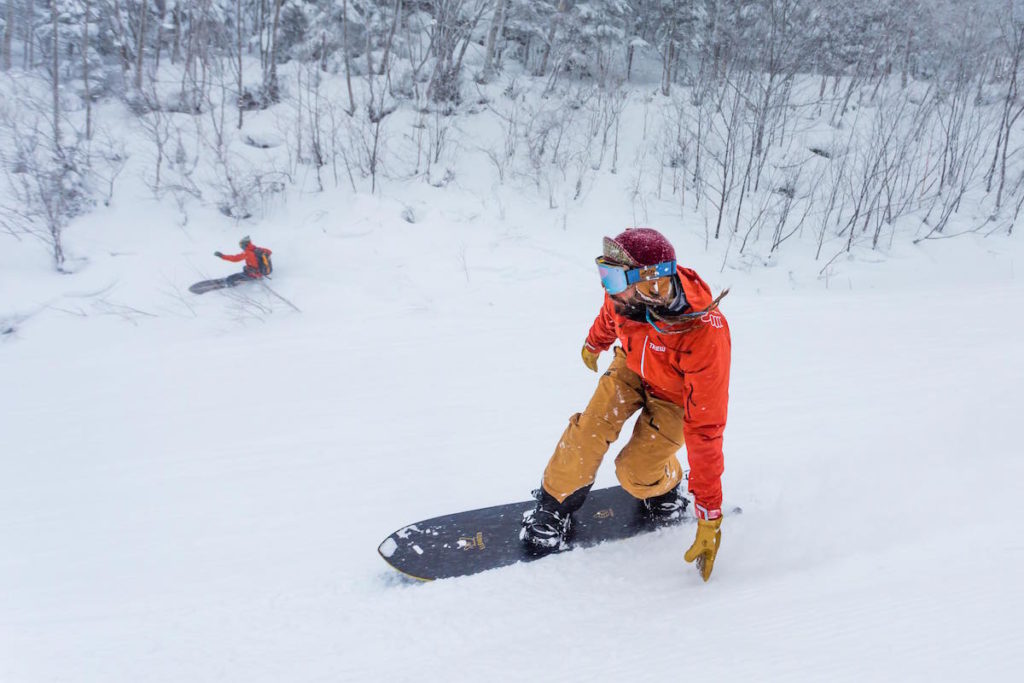
When the student is ready, the teacher appears. Eh?
What happened by the time I arrived (as told by Alx): He had been walking down a different street looking for dinner. No restaurant had caught his attention, so he decided to turn back. At the corner, he randomly took a turn, walked down the street when Karina caught his eye through the window at Ten to Ten Guest House and she and the other girls working waved him in. It happened to be Friday: all-you-can-eat “Oden Night” with Chef Genki for 1,500 yen. Karina invited Alx to join. Karina, and Ten to Ten, is like that.
Cool, laid-back snowboarder dude, who would become my Zen teacher the very same evening, ordered seconds and thirds on oden, as he slalomed his way down the list of fish cakes, stewed kelp tied in knots, and fried blocks of tofu.
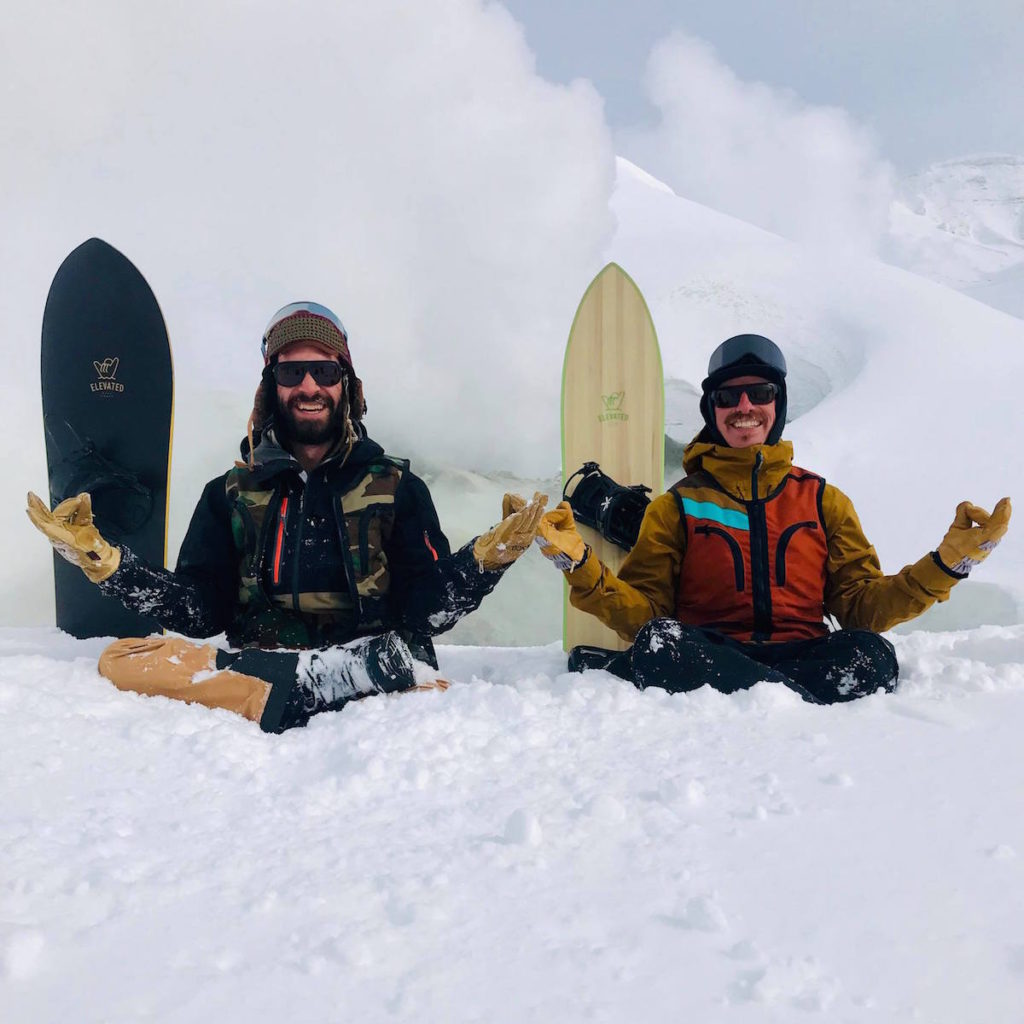
My laptop didn’t stay open for long- very little work got done that evening.
Alx and I talked for hours– in total, probably 6-7 hours that night. In actuality, he talked. I listened as carefully as I could and asked questions. What I hadn’t expected was the hours of deep conversation on spirituality with this guy in the orange hoodie, unraveled strands of hemp yarn dangling from his left armpit. Some seams just barely clung together by a string.
Isn’t it a truth that our true teachers first come into our lives wearing a disguise? A fan of Star Wars wouldn’t disagree. –Hmm. Look. Find him you will.
At that point, I hadn’t even noticed his feather. Yes, his white feather pierced through a loose ravel on the front of his sweater. Not many guys I know carry a feather.
We talked about consciousness (again, he talked- I listened), the future of hacking neurochemicals, Tony Robbins, the Buddhist concept of attachment vs. non-attachment, negative self-talk, love relationships, suffering, and the roots of Japanese mentality. We’re both in Japan, naturally, this level of conversation flowed toward the topic of Zen.
Earlier that month, I had posted in my local Facebook group asking if anyone knew of a temple where I could learn Zen meditation in Sapporo. This was right after a free tour I went on which included a temple visit and zazen meditation experience lead by a monk. After that, I hadn’t taken any steps further.
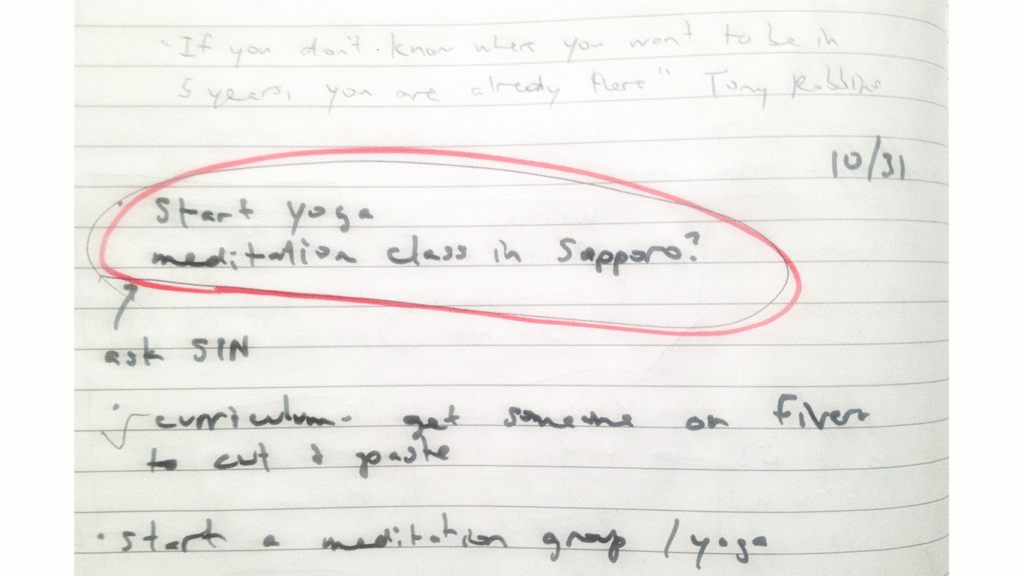
My journal entry on 10/31 (about two months before meeting Alx)
When the student is ready…
It turned out that snowboarder Alx was in his second year specialist degree in mental health studies at the University of Toronto, is a double black belt first degree martial artists, runs a charity for orphaned at-risk girls in Peru (karmaprojects.org), is writing a book called the “Yog in Yoga”, and was on his way via Japan and Australia to lead a yoga retreat in Nepal. And he just received the invitation to teach in Mexico on his phone while I was sitting next to him.
A yogi who trains yoga instructors, who also knows Zen: Alx, my dear teacher.

After finishing off, if I can remember, four rounds of oden, Alx gave me what’s called a koan (公案) in Zen Buddhism. He explained that every teacher of Zen has his own koan.
A koan is what the Zen master uses to assess the consciousness, the level of awakening, of someone who aspires to become a student of Zen. It’s a question designed to not make rational sense, to intentionally elicit your conditioned thinking and eventually strip it all away. It opens the door to a great internal struggle. As it’s impossible to come to the answer using your intellect, the struggle may last days, weeks, or months. Your Western academic training in critical thinking and opinion-making will only get in your way. You, as the student, must go inward.
When you were in elementary school, do you ever remember being asked, “What’s the sound of one hand clapping?”
Your homeroom teacher or best friend in fifth grade may have called it a riddle or a puzzle- it’s not. That’s a centuries-old Zen koan from ancient China.
When that novice learner, that young apprentice monk, is unable to answer the koan correctly, the master waves his hand, shoo-shoo, and sends the poor fellow on his way, back to doing his chores: sweeping the genkan, raking in the temple gardens.
Following the tradition, after giving me his koan, Alx suggested that I light my candle, practice my breathing, inhale, exhale, and meditate on it in the morning. As instructed, I accepted what was an invitation to find the answer to the koan with what Alx called a beginner’s mind- “a mind that is empty is open to everything”. The answer, my awakening, would only come from within me. Alx made it clear that it was not something that he could just give me— “I am and I am not your teacher. The reality is I am your teacher. The truth is I am not your teacher because you hold the teachings deep inside you. I can only provide the space and serve as a guide for you to find and awaken it.”
I embarked on what would turn out to be a week-long journey leading inward. We agreed that I’d bring my answer to him the next day, same time, same place: Ten to Ten.
And with a wave of his hand, go now, shoo, I was sent on my way.
In our case, we shooed off together and went out for some dinner. Evidently, Yogi Zen masters can be friends too.
His koan: “What is at the center of a circle?”

Alx reminded me of what he had taught me earlier that night, “In Zen Real, you have one foot in the reality and one foot in the truth.”
He gave me one example of Zen Real that he had come up with, noting how mathematics leads us to truth, and reality.
The question: What is 1 + 1?
His answer: 1 + 1 = 2…with oneness
“One foot in the finite, and one foot in the infinite.”
Alx encouraged me to “observe reality as it is,” to see things as they are, to observe things as they are. He continued, “freed from your own story and storytelling.”
Alx taught me that in Zen Real, there’s no duality. You observe reality as it is, no good or bad, right or wrong, yin and yang. Only ‘the self’ directly perceives and understands.
Then he gave me another example of a koan that comes from Ikkyū, an eccentric, iconoclastic Zen Buddhist monk and poet of fifteenth century Japan:
“How do you see a gnarled pine tree straight?” (Gnarled meaning the trunk is twisted or tangled up.)
Like Alx did with me, I suggest you light your candle, or whatever ritual it is that you do, and meditate on it tomorrow morning. And, if you choose, you can send your answer to me at info[at]eyesandhour[dot]com.
No money is involved, just like Alx gave his gift to me. As a teacher, I’ll tell you if you’re right or not, and provide you with one or two teachings, possibly a video, to help guide you if you are not able to answer the koan correctly. In the case that I get stuck in helping you, I’ll have to ask Alx, my teacher, for help and then get back to you. Patience, you must have. And then with a wave of my hand, shoo shoo, I’ll send you on your way. You can go fold your laundry and mop the kitchen floor.
At this point, if you are still keen on playing along, I highly suggest you stop reading at the end of this section if you’d prefer that your thinking is not influenced by my initial attempts to answer the koan.
Alx and I agreed that’s it’s better not to reveal the answer at the end of the article, as it would steal your opportunity of coming to the answer on your own if you choose to go along with the experience. Alx taught me, “Zen cannot be taught, it must be experienced.” Now, after the whole process, I understand why.
I want to warn you right now that it’s not easy. Mindwracking is the term I’d use. The answer to this koan was, for the most part, all that I could think about for three days straight.
While I want to encourage you to fully immerse yourself in the experience, I also want to acknowledge that it may not be for you. For me personally, I wasn’t ready until now, at age 38. Even two, three years ago, I would have likely had no interest.
For me, it was my years of invisible suffering, that great internal battle with the relentless negative chatterbox in my mind, all those silent whispers of ‘can’t succeed’, ‘not good enough‘, ‘not smart enough‘, not capable enough‘, that led me here.
The fact that you’re still reading up until now shows me that you’re a seeker. You’re looking for some sort of truth in your life like I was.
It tells me that you, might be ready…
Quoting Alx, “And that my friend, is Zen Real.”
“What is at the center of a circle?”
We agreed to meet at Ten to Ten the next day at the same time for me to give my answer.
Going to meet my teacher on day two, I felt confident that I may have come up with the correct answer. It made sense to me.
Day 2- “What is at the center of a circle?” First attempt
My answer: My conscious mind…
because the circle, or anything for that matter, only exists inside our minds. Therefore, what’s at the center of the circle is also inside our mind because the circle is also inside our mind, which only exists in our conscious mind. The circle is only our perception of what a circle is. So the answer is, what is at the center of the circle is what I perceive to be there, or choose to be there. Whatever I want, the center of the circle is. My conscious awareness.
Having just discovered the book The Tao Te Ching one month earlier, or as I like to say, the book found me, I remembered all the references to circles and referred back to those chapters on my first morning before meditating on the koan. The Tao Te Ching is the foundational text of Taoism in China, which was one of the main influences of Zen.
Chapter 19 in Stephen Mitchell’s translation of the Tao- “Stay at the center of the circle and let all things take their course.”
Chapter 29- “The Master sees things as they are, without trying to control them. She lets them go their own way, and resides at the center of the circle.” (= conscious awareness)
Chapter 11- “We shape clay into a pot, but it is the emptiness inside that holds whatever we want.”
And…I was wrong.
Alx politely commented that my answer was thoughtful, excited, Western-minded, overly academic thinking, what a Zen master might refer to as ‘intellectual diarrhea.’ Not Zen Real.
He told me, translated from Japanese, “If you cannot explain Zen to a fisherman, then you do not know Zen.”
A half hour into our meeting on the second day, I was beginning to feel like all of this was going to be way over my head. This deep philosophical mumbo jumbo was exhausting to listen to. It felt like I was going to struggle through the week and still never get it.
I decided to stick with it, give it some time.
Alx, pointing to the cup on the table in front of me, asked, “What is this?”
I said… “It’s a cup.”
In response, Alex turned the cup upside down on top of his head. “What is it now?”
“A hat.”
Shuffling it across the table: “Now it’s a hockey puck.”
“You see. It is and it is not a cup.”
By the end of the night, I was mentally exhausted. I still had no idea what the answer was but it felt like some of it was starting to sink in.
Day 3- “What is at the center of a circle?” My second attempt
My answer: The reality is, at the center of this circle is paper (holding up the circle I cut out). It depends what the circle is made of. The truth is, the center is at the center of a circle. The middle of circleness. You can’t prove that the center is not at the center of a circle.
And…I was wrong again.
But this time, Alx said I was getting really close. I was almost there.
He said it was even more simple than that. He reminded me, “If you cannot explain Zen to a fisherman, then you do not know Zen.”
What? Was I starting to get it? Could it be true? Up until now, this whole time I’ve been trying to think of the answer, when in fact, answering a Zen koan does not involve thinking at all. Could the answer be that clear and simple, right in front of my face? I just wasn’t seeing it.
Day 3- “What is at the center of a circle?” Third attempt
In reality, a Zen master or teacher would send the student away after not being able to answer the koan correctly. Like I said, this process could take weeks and weeks. On Day 3, I was able to answer the other koan correctly:
“How do you see a gnarled pine tree straight?” – [My answer is redacted. In honor of this exercise and for your own benefit to solve the koan.]
The correct answer is: [Again redacted]
Thus, I was given another attempt to answer “What is at the center of a circle?” because I answered the other koan correctly. My answer was more of a modern-day take, but Alx said I got it.
He taught me the day before, “Once you see the Zen, you see it again and again.”
After a short pause, the answer to the first koan came to me. And once it came to me, I knew it was right (or at least it felt that way.)
My answer: [redacted]
Alx: [response redacted]
Me: [response redacted]
Alx: [redacted]
Me: [response redacted]
Alx: [redacted]
Me: [initial answer redacted]
[full answer redacted]
High-five from Alx! I got the answer. I can still remember the feeling.
My moment of satori.
A few days after Alx left Sapporo on his big snowboarding trip, I shared a video of an old Zen koan with him. It’s the story of a man way high up in a tree and he’s hanging onto a branch for dear life by his teeth with both his arms tied behind his back—basically, there’s no way out, no hope of survival. Some little Zen master walks into the scene and calls out to the man, “ If you want to live, say the one true thing that can save your life.”The tears started to roll down my face. It came to me as clear as could be: the truth. I realized that what Alx had been trying to teach me this whole time was the one word that would save my life and set me free. This was his gift to me.
Alx always said, “The truth is the truth is the truth, nothing as old or as new as the truth.”
With the truth, he set me free.
Afterthought: the gift that Alx gave me
Weeks later now, after meeting Alx at Ten to Ten for the first time, I now realize what he knows and I did not understand about snowboarding backcountry powder with the ever-present risk of an avalanche.
Most of us, including myself, have been sticking to the bunny hill our entire lives, oftentimes in a state of fear, worrying about what dangers may come our way, avoiding the pain of falling down or accidents as much as possible.
The real tragedy comes when we play it safe our whole lives. Then, one day you realize that you ended up never really living life at all.
What Alx taught me is that only when we surrender, and accept the fact of life that we only get one run down the mountain, one chance at being ourselves, that we are truly set free– free of the fear, anxiety, and self-doubt that keeps us from living the one beautiful life we’ve been given– our own.

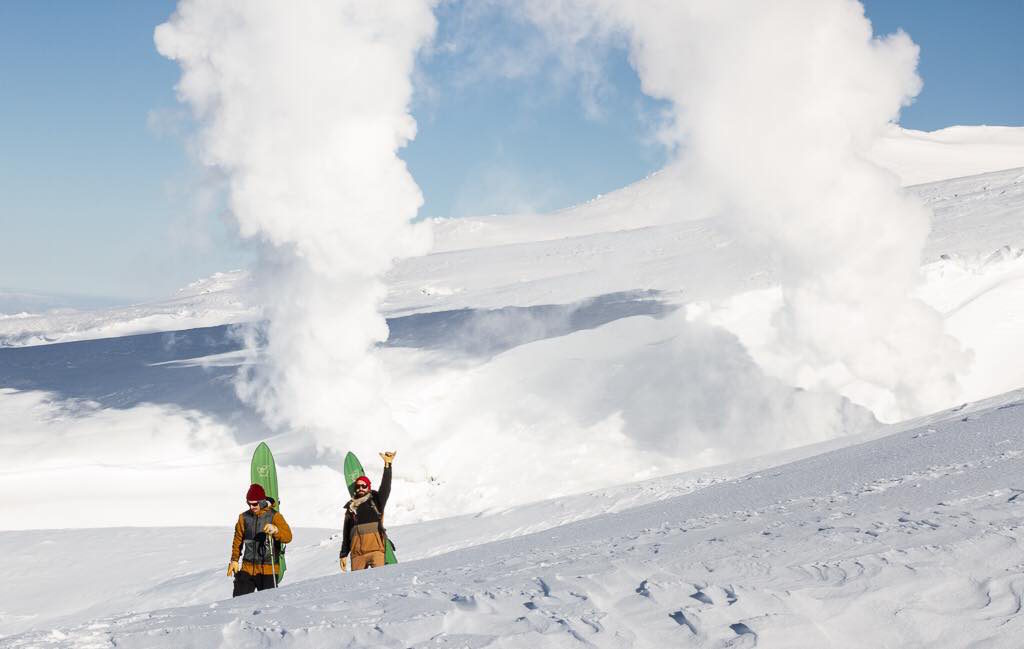

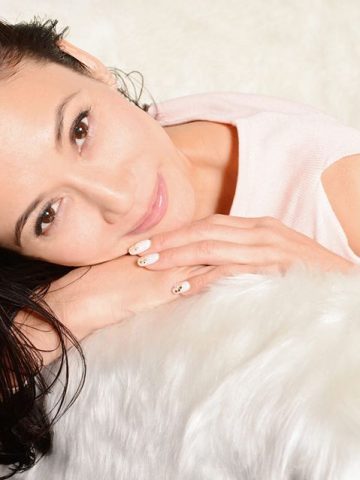

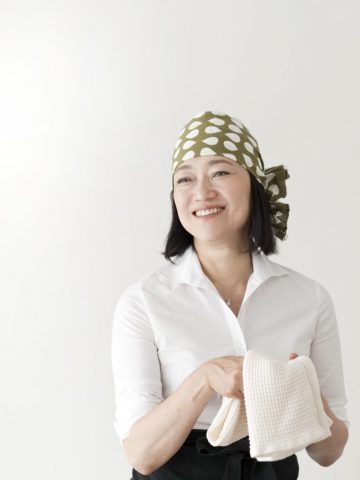
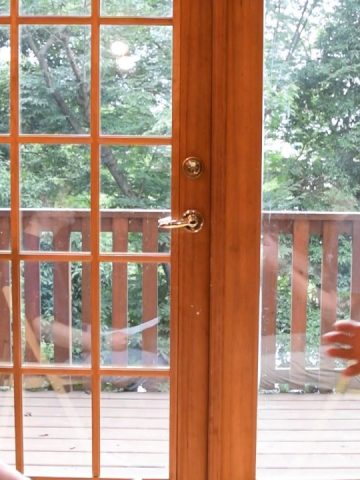
Chieko says
Thank you for sharing your intense experience. I skimmed through this post till the end and did not get the Koan thing. I might need to read it more carefully?
I practice meditation twice a week, and I sometimes listen to Jeff Warren's recording for guided meditation, (It's been like this for the past 5 years)
But I lack some fundamental interest in Buddhism and its teaching, perhaps.
I appreciate if you could write the follow up story on this topic.
Matt says
Thank you for your comment. It's normal that you wouldn't get the koan. It took me a week to solve with my teacher. I've learned a lot from Zen. I believe it's the reason I ended up in Japan, not just the wonderful food and hot springs. haha! Let me know if you have any questions. I always respond to comments. Thank you, Chieko!